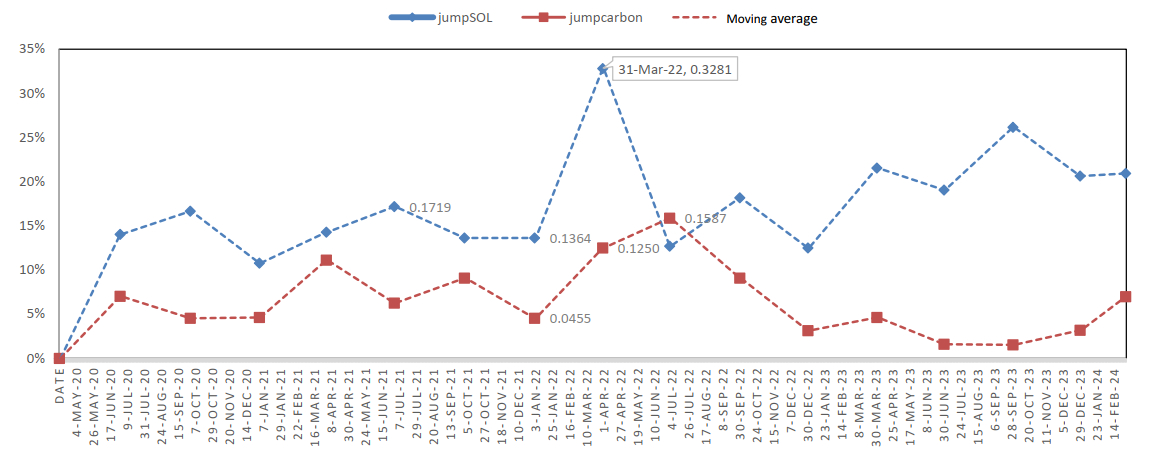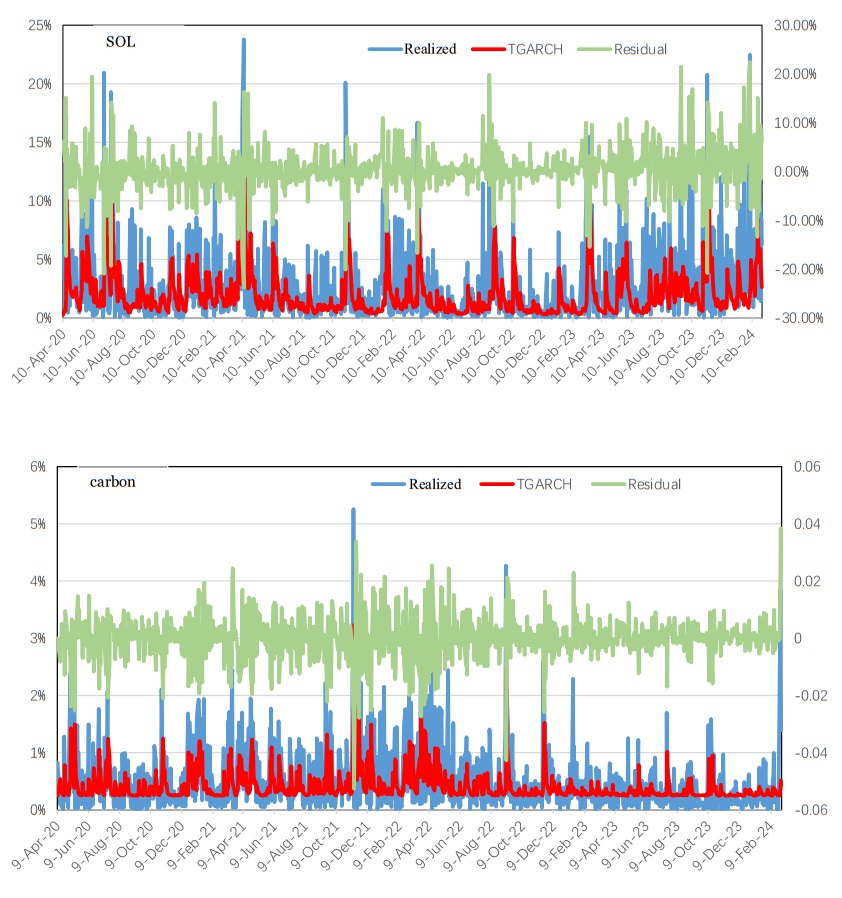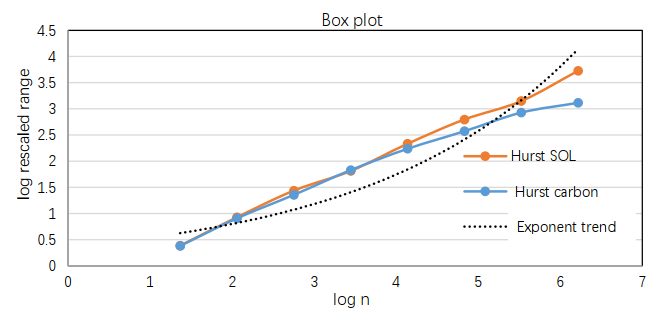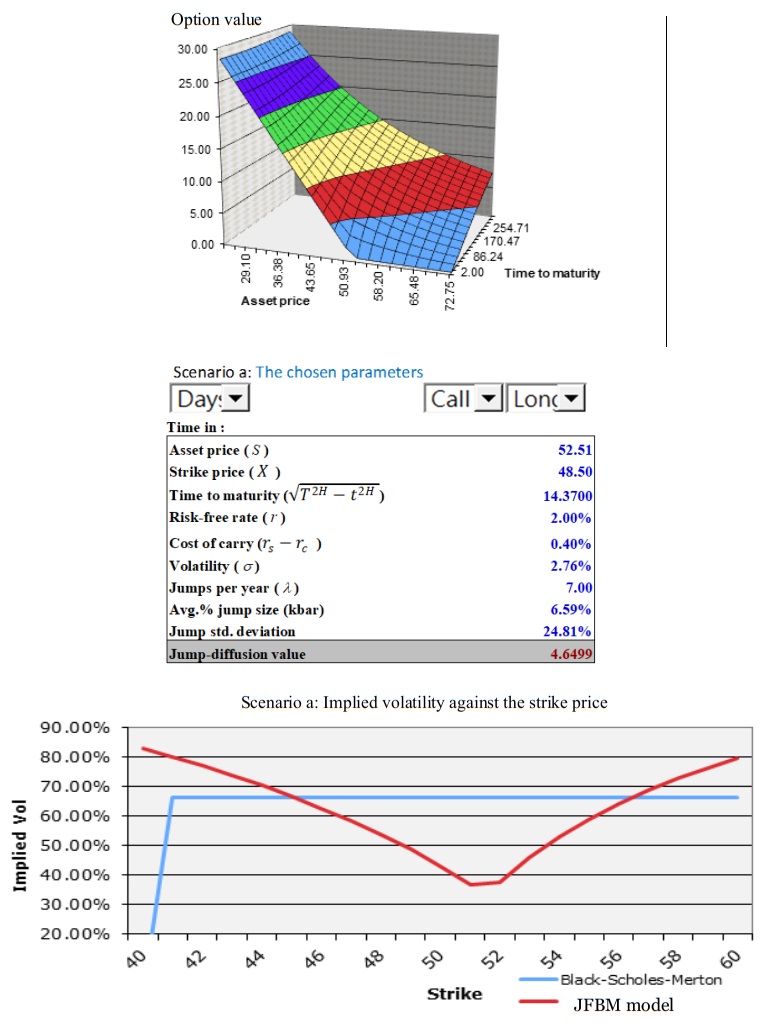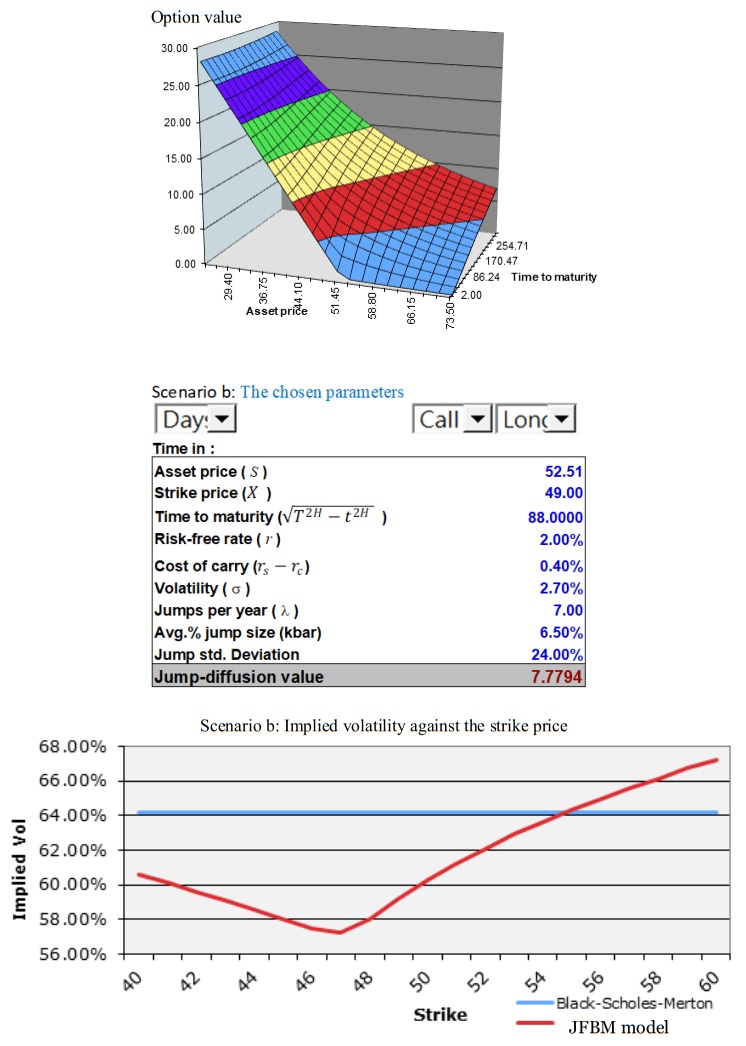To cope with severe climate change, traditional emission reduction and environmental protection measures must be supported by financial instruments. The paper investigates green financial options, measured by the green cryptocurrency (Solana) and carbon emissions allowances, under fractal Brownian motions with jump detection. To this purpose, after observing the dynamic price correlations between all the variables. We introduce a mixed fractional Brownian motion model for the two types of green financial assets with possible jumps driven by an independent Poisson process. Then, pricing European green crypto options and carbon options in a generalized mixed fractional Brownian Motion with jumps detection. This research aims to explore the strategy of European contingent claims written on the underlying asset of green financial assets. When the underlying asset prices follow the mixed fractional Brownian motion with jumps the valuation of European call and put green financial options can be discovered. The finding provides a meaningful and enlightening reference to avoiding green investment risk. More generally, it could be beneficial for responsible investment and risk management in green financial markets under green financial regulations to protect investors and public interests.
1.
Introduction
Consider the following sum of linear ratios optimization problem defined by
where p≥2, A is a m×n order real matrix, b is a m dimension column vector, D is a nonempty bounded polyhedron set, cij,fi,dij, and gi∈R,i=1,2,…,p,j=1,2,…,n, and for any x∈D, n∑j=1dijxj+gi≠0.
The problem (FP) has attracted the attention of many researchers and practitioners for decades. One reason is that the problem (FP) and its special form have a wide range of applications in computer vision, portfolio optimization, information theory, and so on [1,2,3]. Another reason is that the problem (FP) is a global optimization problem, which generally has multiple locally optimal solutions that are not globally optimal. In the past several decades, many algorithms have been proposed for globally solving the problem (FP) and its special form. According to the characteristics of these algorithms, they can be classified into the following categories: Parametric simplex algorithm [4], image space analysis method [5], monotonic optimization algorithm [6], branch-and-bound algorithms [7,8,9,10,11], polynomial-time approximation algorithm [12], etc. Jiao et al. [13,14] presented several branch-and-bound algorithms for solving the sum of linear or nonlinear ratios problems; Huang, Shen et al. [15,16] proposed two spatial branch and bound algorithms for solving the sum of linear ratios problems; Jiao et al. [17] designed an outer space methods for globally solving the min-max linear fractional programming problem; Jiao et al. [18,19,20,21] proposed several outer space methods for globally solving the generalized linear fractional programming problem and its special forms. In addition, several novel optimization algorithms [22,23,24] are also proposed for the fractional optimization problems. However, the above-reviewed methods are difficult to solve the problem (FP) with large-size variables. So it is still necessary to put forward a new algorithm for the problem (FP).
In this paper, based on the branch-and-bound framework, the new linearizing technique, and the image space region reduction technique, an image space branch-and-bound algorithm is proposed for globally solving the problem (FP). Compared with some methods, the algorithm has the following advantages. First, the branching search takes place in the image space Rp of ratios, than in space Rn of variable x, and n usually far exceeds p, this will economize the required computations. Second, based on the characteristics of the problem (EP1) and the structure of the algorithm, an image space region reduction technique is proposed for improving the convergence speed of the algorithm. Third, the computational complexity of the algorithm is analyzed and the maximum iterations of the algorithm are estimated for the first time, which are not available in other articles. In addition, numerical results indicate the computational superiority of the algorithm. Finally, a practical application problem in education investment is solved to verify the usefulness of the proposed algorithm.
The structure of this paper is as follows. In Section 2, we give the equivalent problem (EP1) of problem (FP) and its linear relaxation problem (LRP). In Section 3, an image space branch-and-bound algorithm is presented, the convergence of the algorithm is proved, and its computational complexity is analysed. Numerical results are reported in Section 4. A practical application from education investment problem is solved to verify the usefulness of the algorithm in Section 5. Finally, some conclusions are given in Section 6.
2.
Equivalent problem and its linear relaxation
To find a global optimal solution of the problem (FP), we need to transform the problem (FP) into the equivalent problems (EP) and (EP1). Next, the fundamental assignment is to globally solve the problem (EP1). To this end, for each i=1,2,…,p, we need to compute the minimum value α0i=minx∈D∑nj=1cijxj+fi∑nj=1dijxj+gi and the maximum value β0i=maxx∈D∑nj=1cijxj+fi∑nj=1dijxj+gi of each linear ratio ∑nj=1cijxj+fi∑nj=1dijxj+gi. Next, we first consider the following linear fractional programs:
Since any linear ratio is quasi-convex, the problem (1) can attain the minimum value at some vertex of D. Since n∑j=1dijxj+gi≠0, without losing generality, we can suppose that n∑j=1dijxj+gi>0. Thus, for solving the problem (1), for any i∈{1,2,…,p}, let ti=1n∑j=1dijxj+gi and zj=tixj, then the problem (1) can be converted into the following linear programming problems:
Obviously, if x∗ is a global optimal solution of the problem (1), then if and only if (z∗,t∗i) is a global optimal solution of the problem (2) with z∗=t∗ix∗, and the problems (1) and (2) have the same optimal value. Therefore, α0i can be obtained by solving a linear programming problem (2). Similarly, we can compute the maximum value β0i of each linear ratio over D.
Let Ω0={ω∈Rp∣α0i≤ωi≤β0i, i=1,2,…,p} be the initial image space rectangle, so we can get the equivalent problem (EP) of the problem (FP) as follows:
Obviously, let ω∗i=n∑j=1cijx∗j+fin∑j=1dijx∗j+gi, i=1,2,…,p, if x∗ is a global optimal solution to the problem (FP), then (x∗,ω∗) is a global optimal solution to the problem (EP); conversely, if (x∗,ω∗) is a global optimal solution to the problem (EP), then x∗ is a global optimal solution to the problem (FP). Furthermore, from n∑j=1dijxj+gi≠0, the problem (EP) can be reformulated as the following equivalent problem (EP1).
In the following, for globally solving the problem (EP1), we need to construct its linear relaxation problem, which can offer a reliable lower bound in the branch-and-bound searching process. The detailed deriving process of the linear relaxation problem is given as follows.
For any x∈D and ω∈Ω={ω∈Rp∣αi≤ωi≤βi, i=1,2,…,p}⊆Ω0, we have
and
Consequently, we can construct the linear relaxation problem (LPΩ) of the problem (EP1) over Ω as follows, which is a linear programming problem.
For any Ω={ω∈Rp∣αi≤ωi≤βi,i=1,2,…,p}⊆Ω0, by the constructing method of the problem (LPΩ), all feasible points of the problem (EP1) over Ω are always feasible to the problem (LPΩ), and the optimal value of the problem (LPΩ) is less than or equal to that of the problem (EP1) over Ω. Thus, the optimal value of the problem (LPΩ) can provide a valid lower bound for that of the problem (EP1) over Ω.
Without losing generality, for any Ω={ω∈Rp∣αi≤ωi≤βi, i=1,2,…,p}⊆Ω0, define
then we have the following Theorem 1.
Theorem 1. For any i∈{1,2,…,p}, let ψi(x,ωi),ψ_i(x,ωi) and ¯ψi(x,ωi) be defined in the former, and let Δωi=βi−αi. Then, we have:
Proof. By the definitions of the ¯ψi(x,ωi), ψ_i(x,ωi) and ψi(x,ωi), we can get that
which implies that
Similarly, we also have
which implies that
The proof is completed.◇
From Theorem 1, the functions ψ_i(x,ωi) and ¯ψi(x,ωi) will infinitely approximate the function ψi(x,ωi) as ‖β−α‖→0, which ensures that the problem (LPΩ) will infinitely approximate the problem (EP1) over Ω as ‖β−α‖→0.
3.
Algorithm and its computational complexity
In this section, based on the branch-and-bound framework, the linear relaxation problem, and the image space region reduction technique, we propose an image space branch-and-bound algorithm for globally solving the problem (FP).
3.1. Image space region reduction technique
To improve the convergence speed of the algorithm, for any investigated image space rectangle Ωk, without losing the global optimal solution of the problem (EP1), the region reduction technique aims at replacing Ωk by a smaller rectangle ˉΩk or judging that the rectangle Ωk does not contain the global optimal solution of problem (EP1). For this purpose, let ˆΦk=p∑i=1αki, then the smaller rectangle ˉΩk can be derived by the following theorem.
Theorem 2. Let UBk be the best currently known upper bound at the kth iteration, for any rectangle Ωk=[αk,βk]⊆Ω0, we have the following conclusions:
(ⅰ) If ˆΦk>UBk, then there exists no global optimal solution to the problem (EP1) over Ωk.
(ⅱ) If ˆΦk≤UBk and αkρ≤τkρ≤βkρ for any ρ∈{1,2,…,p}, then there is no global optimal solution to the problem (EP1) over ˆΩk where
with
Proof. For any Ωk=[αk,βk]⊆Ω0, we consider the following two cases:
(ⅰ) If ˆΦk>UBk, then for any feasible solution (ˇx,ˇω) to the problem (EP1) over Ωk, the corresponding target function value Ψ(ˇx,ˇω) to the problem (EP1) over Ωk satisfies that
Thus, there is no global optimal solution to the problem (EP1) over Ωk.
(ⅱ) If ˆΦk≤UBk and αkρ≤τkρ≤βkρ for any ρ∈{1,2,…,p}, then for any feasible solution (ˇx,ˇω) of the problem (EP1) over ˆΩk, we have
Thus, there exists no global optimal solution to the problem (EP1) over ˆΩk.◇
From Theorem 2, the investigated image space rectangle Ωk can be replaced by a smaller rectangle ˉΩk=Ωk∖ˆΩk or judged that the rectangle Ωk does not contain the global optimal solution of the problem (EP1).
3.2. Image space branch-and-bound algorithm (Algorithm ISBBA)
Definition 1. Denote xk as a known feasible solution for problem (FP), and denote v∗ as the global optimal value for problem (FP), if G(xk)−v∗≤ε, then xk is called as a global ε−optimum solution for problem (FP).
The basic steps of the proposed image space branch-and-bound algorithm are given as follows.
Step 0. Given the termination error ε>0 and the initial rectangle Ω0. Solve the problem (LP(Ω0)) to obtain its optimal solution (x0,ˆω0) and optimal value Ψ(x0,ˆω0). Set LB0=Ψ(x0,ˆω0), let ω0i=∑nj=1cijx0j+fi∑nj=1dijx0j+gi,i=1,2,…,p,UB0=Ψ(x0,ω0). If UB0−LB0≤ε, then stops, and x0 is a global ε -optimal solution to the problem (FP). Otherwise, let F={(x0,ω0)} be the set of feasible points, and let k=0, T0={Ω0} is the set of all active nodes.
Step 1. Using the maximum edge binding method of rectangles to subdivide Ωk into two new sub-rectangles Ωk1 and Ωk2, and let H={Ωk1,Ωk2}.
Step 2. For each rectangle Ωkσ(σ=1,2), use the image space region reduction technique proposed in Section 3.1 to compress its range, and still denote the remaining region of Ωkσ as Ωkσ, if Ωkσ≠∅, then solve the problem (LP(Ωkσ)) to obtain its optimal solution (xΩkσ,ˆωΩkσ) and optimal value Ψ(xΩkσ,ˆωΩkσ). Let LB(Ωkσ)=Ψ(xΩkσ,ˆωΩkσ), ωΩkσi=∑nj=1cijxΩkσj+fi∑nj=1dijxΩkσj+gi,i=1,2,…,p, and F=F⋃{(xΩkσ,ωΩkσ)}. If UBk<LB(Ωkσ), then let H=H∖Ωkσ,F=F∖{(xΩkσ,ωΩkσ)} and Tk=Tk∖{Ωkσ}. Update the upper bound by UBk=min(x,ω)∈FΨ(x,ω) and denote by (xk,ωk)=argmin(x,ω)∈FΨ(x,ω). Let Tk=(Tk∖Ωk)∪H and LBk=min{LB(Ω)∣Ω∈Tk}.
Step 3. Set Tk+1={Ω∣UBk−LB(Ω)>ε,Ω∈Tk}. If Tk+1=∅, then the algorithm stops with that xk is a global ε -optimal solution to the problem (FP). Otherwise, select the rectangle Ωk+1 satisfying that Ωk+1=argminΩ∈Tk+1LB(Ω), set k=k+1, and return to Step 1.
3.3. Global convergence analysis
In the following, we will discuss the global convergence of the algorithm.
Theorem 3. Let v∗ be the global optimal value of the problem (FP), Algorithm ISBBA either ends at the global optimal solution of the problem (FP) or generates an infinite sequence of feasible solutions so that its any accumulation point is the global optimal solution of the problem (FP).
Proof. If Algorithm ISBBA is terminated finitely after k iterations, then when Algorithm ISBBA is terminated, we obtain a better feasible solution xk of the problem (FP) and a better feasible solution (xk,ωk) of the problem (EP) with ωki=∑nj=1cijxkj+fi∑nj=1dijxkj+gi,i=1,2,…,p, respectively. By the termination conditions, the updating method of the upper bound, and the steps of Algorithm ISBBA, we can get the following inequalities:
By combining the above equalities and inequalities, we can get
Therefore, we can get that xk is an ϵ−global optimal solution of the problem (FP).
If Algorithm ISBBA produces an infinite sequence of feasible solutions {xk} for the problem (FP) and an infinite sequence of feasible solutions {(xk,ωk)} for the problem (EP) with ωki=∑nj=1cijxkj+fi∑nj=1dijxkj+gi,i=1,2,…,p, respectively. Without losing generality, let x∗ be an accumulation point of {xk}, we can get that limk→∞xk=x∗.
By the continuity of the ∑nj=1cijxj+fi∑nj=1dijxj+gi, ∑nj=1cijxkj+fi∑nj=1dijxkj+gi=ωki∈[αki,βki],i=1,2,…,p, and the exhaustiveness of the partitioning method, we can get that
Thus, (x∗,ω∗) is a feasible solution for the problem (EP). Also since {LBk} is an increasing lower bound sequence satisfying that LBk≤v∗, we can follow that
Hence, by the method of updating upper bound and the continuity of G(x), we can get that
From (3) and (4), we can get that
Therefore, any accumulation point x∗ of the infinite sequence {xk} of feasible solutions is a global optimal solution for the problem (FP), and the proof of the theorem is completed.◇
3.4. Computational complexity of the algorithm
In this subsection, by analysing the computational complexity of Algorithm ISBBA, we estimate the maximum iteration times of Algorithm ISBBA. For convenience, we first define the size of a rectangle
as
Theorem 4. For any given termination error ε>0, if there exists a rectangle Ωk, which is formed by Algorithm ISBBA at the kth iteration, and which is satisfied with δ(Ωk)≤εp, then we have that
where LB(Ωk) represents the optimal value for the problem (LP(Ωk)), and UBk represents the currently known best upper bound of the global optimal value of the problem (EP).
Proof. Without loss of generality, assume that (xk,ˆωk) is the optimal solution of the linear relaxation programming (LP(Ωk)), and let ωki=n∑j=1cijxkj+fin∑j=1dijxkj+gi,i=1,2,…,p, then (xk,ωk) must be a feasible solution to the problem (EP(Ωk)).
By utilizing the definitions of UBk and LB(Ωk), we have that
Thus, by steps of Algorithm ISBBA, we can follow that
Furthermore, from the above formula and δ(Ωk)≤εp, we can get that
and the proof of the theorem is completed.◇
According to Step 3 of Algorithm ISBBA, from Theorem 4, if δ(Ωk)≤εp, then it can be seen easily that the rectangle Ωk will be deleted. Thus, if the sizes of all sub-rectangles Ω generated by Algorithm ISBBA meet δ(Ω)≤εp, then Algorithm ISBBA will stop. The maximum iteration times of Algorithm ISBBA can be estimated by using Theorem 4, see Theorem 5 for details.
Theorem 5. Given the termination error ε>0, Algorithm ISBBA can find an ε-global optimal solution to the problem (FP) after at most
iterations, where Ω0={ω∈Rp|α0i≤ωi≤β0i,i=1,2,…,p}.
Proof. Without losing generality, we assume that the i−th edge of the rectangle Ω0 is continuously selected for dividing γi times, and suppose that after γi iterations, there exists a sub-interval Ωγii=[αγii,βγii] of the interval Ω0i=[α0i,β0i] such that
From the partitioning process of Algorithm ISBBA, we have that
From (5) and (6), we can get that
i.e.,
Next, we let
Let Λ1=p∑i=1ˉγi, then after Λ1 iterations, Algorithm ISBBA will generate at most Λ1+1 sub-rectangles, denoting these sub-rectangles as Ω1,Ω2,…,ΩΛ1+1, which must meet
where δ(ΩΛ1)=δ(ΩΛ1+1)=max{βˉγii−αˉγii,i=1,2,…,p} and
Furthermore, put these Λ1+1 sub-rectangles into the set TΛ1+1, i.e.,
By (5), we have that
Thus, by (8), Theorem 4, and Step 3 of Algorithm ISBBA, the sub-rectangles ΩΛ1 and ΩΛ1+1 have been examined clearly, which should be discarded from the partitioning set TΛ1+1. Next, the remaining sub-rectangles are placed in the set TΛ1, where
and the remaining sub-rectangles Ωt (t=1,…,Λ1−1) will be examined further.
Next, consider the sub-rectangle ΩΛ1−1, by using the branching rule, we can subdivide the sub-rectangle ΩΛ1−1 into two sub-rectangles ΩΛ1−1,1 and ΩΛ1−1,2, which satisfies that
and
Therefore, after Λ1+(21−1) iterations, the sub-rectangle ΩΛ1−1 has been examined clearly. By (8), Theorem 4, and Step 3 of Algorithm ISBBA, ΩΛ1−1 should be discarded from the partitioning set TΛ1. Furthermore, the remaining sub-rectangles will be placed in the set TΛ1−1, where
Similarly, after Algorithm ISBBA executed Λ1+(21−1)+(22−1) iterations, the sub-rectangle ΩΛ1−2 has been examined clearly, and which should be discarded from the partitioning set TΛ1−1. Furthermore, the remaining sub-rectangles will be put into the set TΛ1−2, where
Reduplicate the above procedures, until all sub-rectangles Ωt(t=1,2,…,Λ1+1) are completely eliminated from Ω0. Thus, by (7), after at most
iterations, Algorithm ISBBA will stop, and the proof of the theorem is completed. ◇
Remark 1. By Theorem 5, from the above complexity analysis of Algorithm ISBBA, the running time of Algorithm ISBBA is bounded by 2ΛT(m+2p,n+p) for finding an ε-global optimal solution for the problem (FP), where T(m+2p,n+p) represents the time taken to solve a linear programming problem with (n+p) variables and (m+2p) constraints.
4.
Numerical experiments
In this section, we numerically compare Algorithm ISBBA with the software "BARON" [25] and the branch-and-bound-algorithm presented in Jiao & Liu [10], denoted by Algorithm BBA-J. All used algorithms are coded in MATLAB R2014a, all test problems are solved on the same microcomputer with Intel(R) Core(TM) i5-7200U CPU @2.50GHz processor and 16 GB RAM. We set the maximum time limit for all algorithms to 4000 seconds. These test problems and their numerical results are listed as follows.
Test Problem 1 is a problem with large-size variables, with the given termination error ϵ=10−2, numerical comparisons among Algorithm ISBBA, BBA-J, and BARON are listed in Table 1, respectively. Test Problem 2 is a problem with the large-size number of ratios, with the given termination error ϵ=10−3, numerical comparisons among Algorithm ISBBA and BARON are listed in Table 2, respectively. For test Problems 1 and 2, we solved arbitrary ten independently generated test examples and recorded their best, worst, and average results among these ten test examples, and we highlighted in bold the winners of average results in their numerical comparisons. What needs to be pointed out here is that "⋆" represents that the used algorithm failed to terminate in 4000s. From the numerical results for Problem 1 in Table 1, first, we see that the software BARON is more time-consuming than Algorithm ISBBA, though the number of iterations for BARON is smaller than Algorithm ISBBA. Second, in terms of computational performance, Algorithm ISBBA outperforms Algorithm BBA-J. Especially, when we fixed m=100, let p=2 and n=8000,10000 or 20000, or let p=3 and n=8000, BARON failed to terminate in 4000s for all arbitrary ten independently generated test examples; when we fixed m=100, let p=3 and n=8000, Algorithm BBA-J and BARON all failed to terminate in 4000s for all arbitrary ten independently generated test examples, but in all cases, Algorithm ISBBA can globally solve all arbitrary ten independently generated test examples.
From the numerical results for Problem 2 in Table 2, we can see that when we fixed p=10 and n=500, or p=15 and n=500, or p=20 and n=400, the software BARON failed to terminate in 4000s for all arbitrary ten independently generated examples, but Algorithm ISBBA can successfully find the globally optimal solutions of all arbitrary ten independently generated tests. It should be noted that, when p is larger for Problem 2, Algorithm BBA-J failed to solve all arbitrary ten tests in 4000s. Therefore, we just report the computational comparisons among Algorithm ISBBA and BARON in Table 2, this indicates the robustness and stability of Algorithm ISBBA.
Problem 1.
where cij,dij,fi, and gi∈R,i=1,2,…,p; A∈Rm×n, b∈Rm; cij, dij, and all elements of A are all randomly generated from [0,10]; all elements of b are equal to 10; fi and gi,i=1,2,…,p, are all randomly generated from [0,1].
Problem 2.
where γij,ξi,δij,ηi∈R, i=1,2,…,p,j=1,2,…,n; A∈Rm×n, b∈Rm; all γij and δij are randomly generated from [−0.1,0.1]; all elements of A are randomly generated from [0.01,1]; all elements of b are equal to 10; all ξi and ηi satisfies that n∑j=1γijxj+ξi>0 and n∑j=1δijxj+ηi>0.
5.
Application in education investment
Consider finding the optimal solution of the education investment problem, whose mathematical modelling can be given as below:
where cji (j=1,2,…,p,i=1,2,…,n) is the i−th invested fund of the j−th education investment, xi (i=1,2,…,n) is the investment percentage of the i−th education investment, dji (j=1,2,…,p,i=1,2,…,n) is the i−th output fund of the j−th education investment.
The parameters of an education investment problem are given as below:
Using the presented algorithm in this article to solve the above problem, the global optimal solution can be obtained as below:
It is to say, the optimal investment percentage of these three kinds of education investment is 0.7286,0.0000,0.2714, respectively.
6.
Conclusions
We study the problem (FP). Based on the image space search, the new linearizing technique, and the image space region reduction technique, we propose an image space branch-and-bound algorithm. In contrast to the existing algorithm, the proposed algorithm can find an ϵ-approximate global optimal solution of the problem (FP) in at most (2p∑i=1⌈log2p(β0i−α0i)ε⌉−1) iterations. Numerical results show the computational superiority of the algorithm.
A potential field for future research lies in investigating the existence of analogous linear or convex relaxation problems with closed-form solutions in cases where both the numerators and denominators are nonlinear functions. Furthermore, there is also need to design an efficient algorithm for globally solving generalized nonlinear ratios optimization problems with non-convex feasible region, as well as for more general non-convex ratios optimization problems under uncertain variable environments.
Author contributions
All authors of this article have been contributed equally. All authors have read and approved the final version of the manuscript for publication.
Use of AI tools declaration
The authors declare they have not used Artificial Intelligence (AI) tools in the creation of this article.
Acknowledgments
This paper is supported by the National Natural Science Foundation of China (12001167), the China Postdoctoral Science Foundation (2018M642753), the Key Scientific and Technological Research Projects in Henan Province (232102211085; 202102210147), the Research Project of Nanyang Normal University(2024ZX014).
Conflict of interest
The author declares no conflict of interest.









 DownLoad:
DownLoad:



